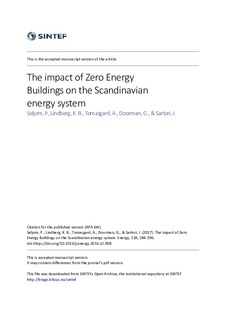| dc.contributor.author | Sandberg, Linn Ingunn Christie | |
| dc.contributor.author | Lindberg, Karen Byskov | |
| dc.contributor.author | Tomasgard, Asgeir | |
| dc.contributor.author | Doorman, Gerard L. | |
| dc.contributor.author | Sartori, Igor | |
| dc.date.accessioned | 2018-04-23T10:42:55Z | |
| dc.date.available | 2018-04-23T10:42:55Z | |
| dc.date.created | 2017-01-03T10:31:56Z | |
| dc.date.issued | 2017 | |
| dc.identifier.citation | Energy. 2017, 118 284-296. | nb_NO |
| dc.identifier.issn | 0360-5442 | |
| dc.identifier.uri | http://hdl.handle.net/11250/2495444 | |
| dc.description.abstract | This paper investigates how an extensive implementation of net Zero Energy Buildings (ZEBs) affects cost-optimal investments in the Scandinavian energy system towards 2050. Analyses are done by a stochastic TIMES model with an explicit representation of the short-term uncertainty related to electricity supply and heat demand in buildings. We define a nearly ZEB to be a highly efficient building with on-site PV production. To evaluate the flexibility requirement of the surrounding energy system, we consider no use of energy storage within the ZEBs. The results show that ZEBs reduce the investments in non-flexible hydropower, wind power and Combined Heat and Power, and increase the use of direct electric heating and electric boilers. With building integrated PV production of 53 TWh in 2050, ZEBs increase the Scandinavian electricity generation by 16 TWh and increase the net electricity export by 19 TWh. Although the increased production reduces the electricity prices, the low heat demand in ZEBs gives a drop in the electricity consumption by 4 TWh in 2050. Finally, the results demonstrate that the Scandinavian energy system is capable of integrating a large amount of ZEBs with intermittent PV production due to the flexible hydropower in Norway and Sweden. | nb_NO |
| dc.language.iso | eng | nb_NO |
| dc.publisher | Elsevier | nb_NO |
| dc.subject | Stochastic programming | nb_NO |
| dc.subject | Photovoltaic power | nb_NO |
| dc.subject | Energy system model | nb_NO |
| dc.subject | Buildings | nb_NO |
| dc.subject | Zero Energy Buildings (ZEB) | nb_NO |
| dc.subject | Times modeling | nb_NO |
| dc.subject | Photovoltaic system | nb_NO |
| dc.subject | Heating | nb_NO |
| dc.title | The impact of Zero Energy Buildings on the Scandinavian energy system | nb_NO |
| dc.type | Journal article | nb_NO |
| dc.type | Peer reviewed | nb_NO |
| dc.description.version | acceptedVersion | nb_NO |
| dc.rights.holder | © Preprint version the authors This is the authors' accepted manuscript to the article. The final publication is available at https://doi.org/10.1016/j.energy.2016.12.008 | nb_NO |
| dc.subject.nsi | VDP::Teknologi: 500 | nb_NO |
| dc.source.pagenumber | 284-296 | nb_NO |
| dc.source.volume | 118 | nb_NO |
| dc.source.journal | Energy | nb_NO |
| dc.identifier.doi | 10.1016/j.energy.2016.12.008 | |
| dc.identifier.cristin | 1419700 | |
| dc.relation.project | Norges forskningsråd: 257660 | nb_NO |
| dc.relation.project | Norges forskningsråd: 209697 | nb_NO |
| dc.relation.project | Norges forskningsråd: 193830 | nb_NO |
| cristin.unitcode | 7401,30,20,0 | |
| cristin.unitname | Bygninger og installasjoner | |
| cristin.ispublished | true | |
| cristin.fulltext | original | |
| cristin.fulltext | postprint | |
| cristin.qualitycode | 2 | |
